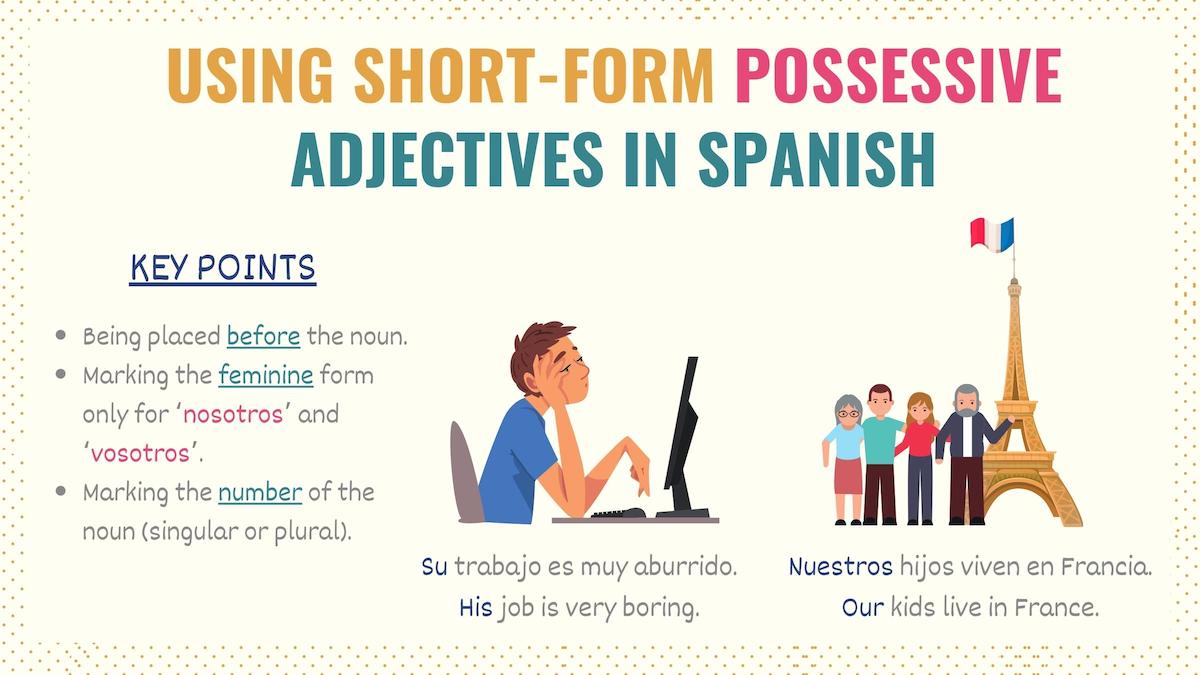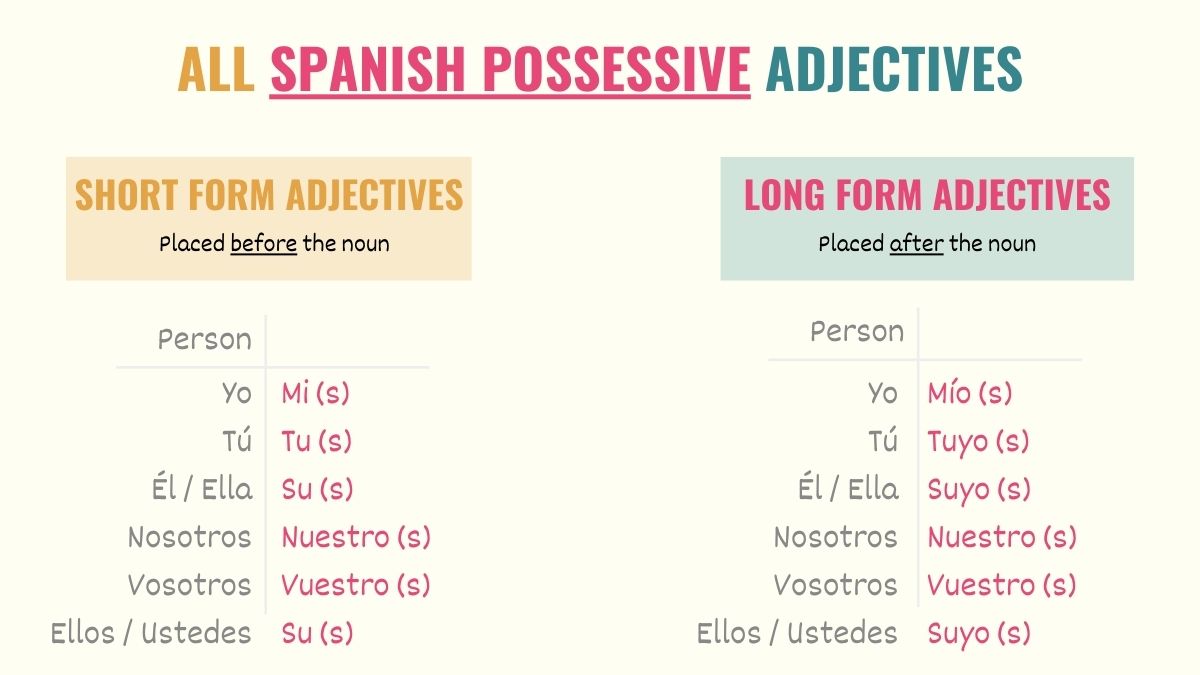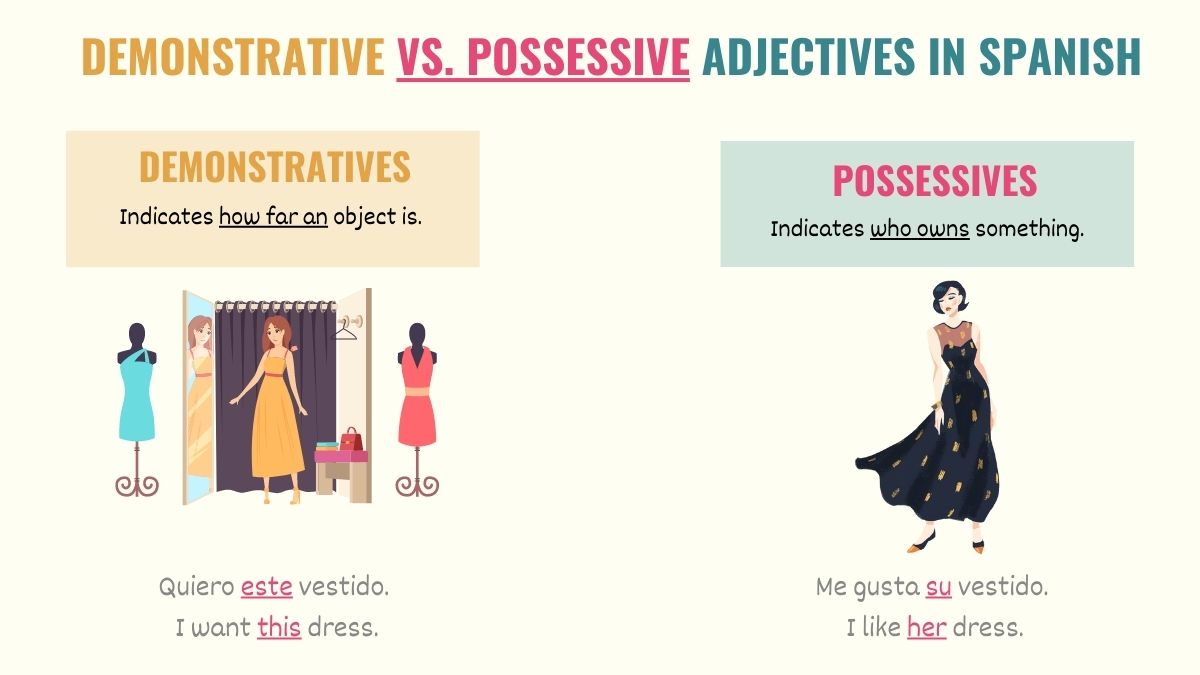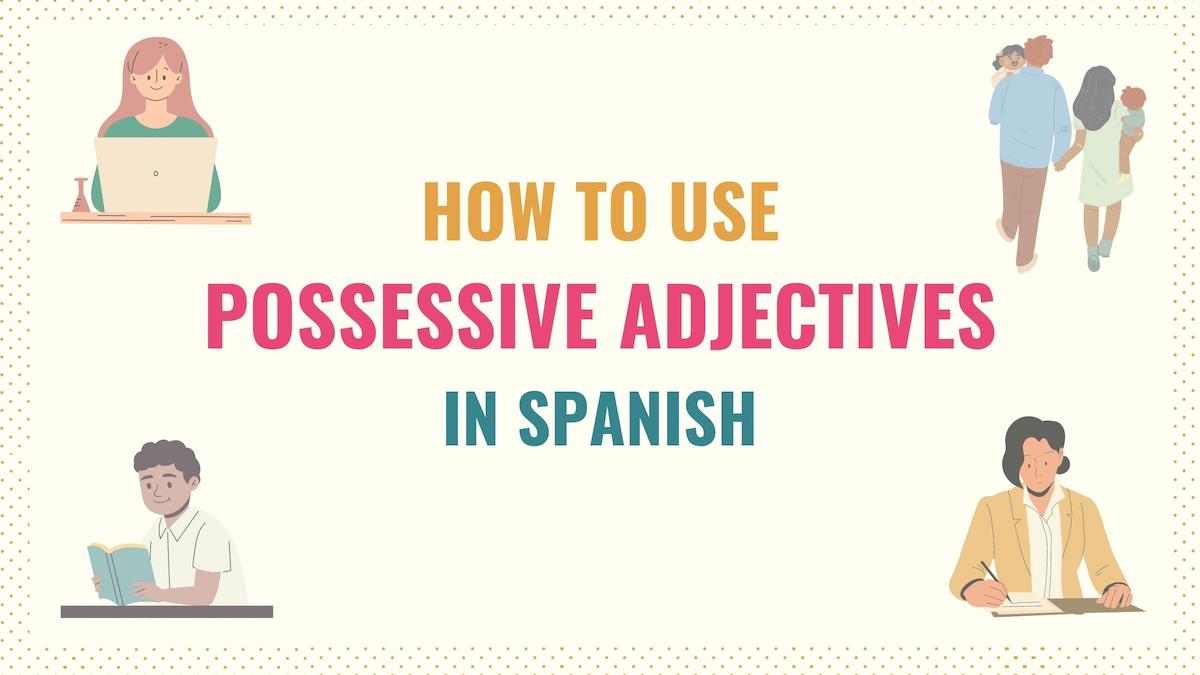Showing possession is a basic communication skill. And to do so, we use a special set of adjectives. But because many people hear about this term for the first time, a lot of learners wonder what possessive adjectives in Spanish are.
A Spanish possessive adjective is a word that indicates that something belongs to someone. In Spanish, possessive adjectives are: mi, tu, su, nuestro, nuestra, vuestro, and vuestra, as well as their plural form.
Because it may be a new topic for them, many people are unsure of how to use these types of adjectives. To help you overcome this, in this article, you’ll learn:
The topics you’ll learn are:
- Types of possessives adjectives and uses
- Spanish possessive pronouns
- Key points
- Next Steps & Resources for Adjectives
Possessive Adjectives in Spanish: Types & Uses
In simple terms, Spanish possessive adjectives are a type of adjective that help you to talk about someone’s possessions or belongings. Since they express possession, we use them to say to whom something belongs.
Just like English, each Spanish personal pronoun has its corresponding possessive adjective. So, you need to make sure you choose the correct adjective.
Short-form possessive adjectives in Spanish
- Mi / Mis: My
- Tu / Tus: Your
- Su / Sus: His / Her
- Nuestro(s) / Nuestra(s): Our
- Vuestro(s) / Vuestra(s): Your
- Su / Sus: Your / Their
The most common type of possessive adjectives in Spanish is what people call short-form of possessive adjectives (unstressed adjectives for us grammar freaks). These possessive adjectives are distinguished by:
- Being placed before the noun.
- Marking the feminine form only for ‘nosotros’ and ‘vosotros’.
- Marking the number of the noun (singular or plural).

Notice that, with this adjective form, you only have to worry about the gender of Spanish nouns when expressing possession for vosotros or nosotros.
Check these examples:
[Possessive adj.] + [noun]
Esta es mi casa.
This is my house.
Su trabajo es muy aburrido.
His job is very boring.
James, ¿este es su carro?
Is this your car, James?
Me gustan sus vestidos, chicas.
I like your dresses, girls.
Nuestra vecina habla español.
Our neighbor speaks Spanish.
Nuestros hijos viven en Francia.
Our kids live in France.
Take Note: Accent marks in Spanish can change the meaning of a word. Tú is a personal pronoun, while tu is its possessive.
What are Spanish long-form possessive adjectives?
Spanish stressed possessive adjectives, or long-form possessive adjectives for the non-grammar freak, are adjectives that we use to emphasize possession. These possessive adjectives in Spanish are placed after the noun and mark the gender of the noun.
These are all the Spanish stressed possessive adjectives:
| Person | Masc. possessive adjective | Fem. possessive adjective | English |
|---|---|---|---|
| Yo | Mío / Míos | Mía / Mías | My / Mine |
| Tú | Tuyo / Tuyos | Tuya / Tuyas | Your / Yours |
| Él / Ella | Suyo / Suyos | Suya / Suyas | His / Her / Hers |
| Nosotros | Nuestro / Nuestros | Nuestra / Nuestras | Our / Ours |
| Vosotros | Vuestro / Vuestros | Vuestra / Vuestras | Your / Yours |
| Ellos / Ellas | Suyo / Suyos | Suya / Suyas | Your / Yours |
Note that Spanish stressed possessive adjectives have two different translations, which will vary depending on the specific sentence. Check the examples below:
Sebastian es amigo mío.
Sebastian is a friend of mine.
Quiero un beso tuyo.
I want a kiss from you.
¿Mi abuela era amiga suya?
Was my grandma a friend of yours?
¡Dios mío! ¡Qué tarde es!
My God! It’s very late!
¡Lo siento, eso es problema tuyo!
I’m sorry, that’s your problem!
Given that their applications are minimal, long-form Spanish possessive adjectives are not very common. You may find them in movies, books, or situations where people need to add emphasis to their sentences.

Take Note: Many students confuse possessives with Spanish demonstrative adjectives. Spanish demonstratives are not related to possession. In fact, we use them to explain how far something is in relation to the speaker.

Advanced tip: expressing possession with Spanish articles
As its name suggests, possessive adjectives are meant to express possession. However, did you know that you can also use Spanish definite articles to convey the same idea? Let me show you how this works!
We native Spanish speakers use definite articles instead of possessive adjectives when it’s very clear that an object belongs to us.
[Definite article] + [noun]
Me duele la cabeza.
My head hurts.
Robert se quebró el brazo.
Robert broke his arm.
La novia no lo dejó ir.
His girlfriend didn’t let him go.
Perdí las llaves y el celular.
I lost my keys and my phone.
If you ever wondered why we use Spanish articles with body parts, it’s because it’s more than clear that your eyes, head, arms, legs, etc. belong to you!
What Are Possessive Pronouns in Spanish
Spanish possessive adjectives are closely related to possessive pronouns. They both have the same purpose: to express possession. But unlike adjectives, Spanish pronouns don’t accompany the noun; they rather replace it:
Possessive adjective:
Mi perro es muy pequeño.
My dog is very small.
Ese perro pequeño es mío.
That small dog is mine.
Possessive pronoun:
El tuyo es muy grande.
Yours is very big.
As you can see, the second example doesn’t mention the word ‘perro’. Because we’ve discussed that topic before, we can replace perro with the corresponding possessive pronoun. So, to use Spanish pronouns, you have to make sure that the people involved in the conversation understand what you’re talking about.
Spanish possessive pronouns are:
| Person | Spanish possessive pronoun | English |
|---|---|---|
| Yo | Mío / Míos | Mine |
| Tú | Tuyo / Tuyos | Yours |
| Él / Ella | Suyo / Suyos | His / Hers |
| Nosotros | Nuestro / Nuestros | Ours |
| Vosotros | Vuestro / Vuestros | Yours |
| Ellos / Ustedes | Suyo / Suyos | Yours |
If the belonging you’re referring to is a feminine word in Spanish, you’ll need to transform these pronouns into their feminine forms. Check these examples:
[Verb conjugated] + (definite article) + [possessive pronoun]
Disculpe, ¿es suya?
Excuse me, is this yours?
Tomé tu cargador. El mío no funciona.
I took your charger. Mine doesn’t work.
Encontré mi libro. Juan tiene el tuyo.
I found my book. Juan has yours.
Su pastel está muy bueno, pero el nuestro es mejor.
Their cake is very good, but ours is better.
Since they look very similar, people often confuse Spanish possessive pronouns with long-form possessive adjectives. But as you can see in the examples above, there are no nouns immediately before possessive pronouns.
Additionally, we can introduce the noun at the beginning of the sentence. However, in this case, the possessive pronoun must always be preceded by a Spanish definite article.
Key Points of Possessive Adjectives & Pronouns
Possessive adjectives and pronouns are essential to delivering a basic yet important message: who has ownership over something. Here are some key points that you should never forget:
- Depending on their length and position, they can be classified into non-stressed or stressed adjectives.
- Non-stressed adjectives or short-form possessive adjectives are placed before the noun.
- Long-form possessive adjectives or stressed adjectives are placed after the noun, and they’re used for emphatic purposes.
- Examples of short-form adjectives are mi, tu, su and nuestro. Aside from ‘nuestro’ and ‘vuestro’, the rest of these possessive adjectives don’t mark the gender of the noun.
- When the ownership is clear, Spanish definite articles can be used instead of possessive adjectives to indicate possession.
- Spanish possessive pronouns replace nouns.
- Mío, tuyo, suyo, and nuestro are examples of possessive pronouns in Spanish.
Possessive Adjectives Related Resources
A possessive is a type of adjective. Like these words, there are other adjectives in Spanish that you can use to describe or modify a noun. So, your next step is learning some common adjectives you can add to your vocabulary.
Possessive adjectives in Spanish are a type of determiner. As a result, you should learn other determiners that can help you identify nouns more precisely.
Download the Spanish Possessive Adjectives PDF
Grammar topics such as possessive adjectives and pronouns can be difficult to learn and harder to remember when you only study it once. You can download a copy of the possessive adjectives in Spanish PDF for free containing all the graphics and key points for this subject and review it whenever you’d like!



